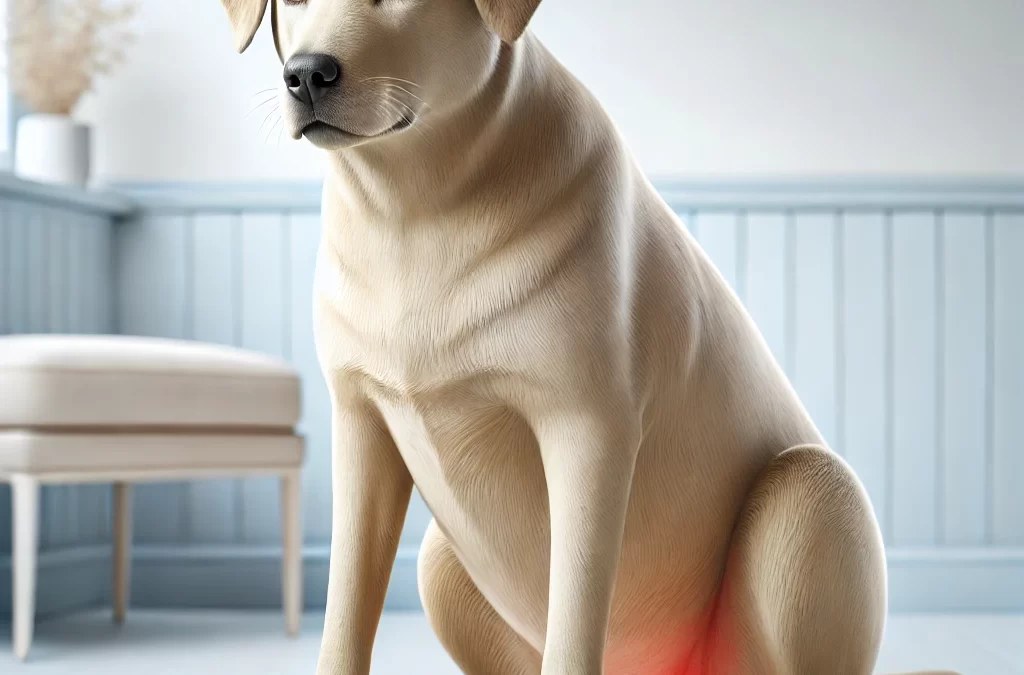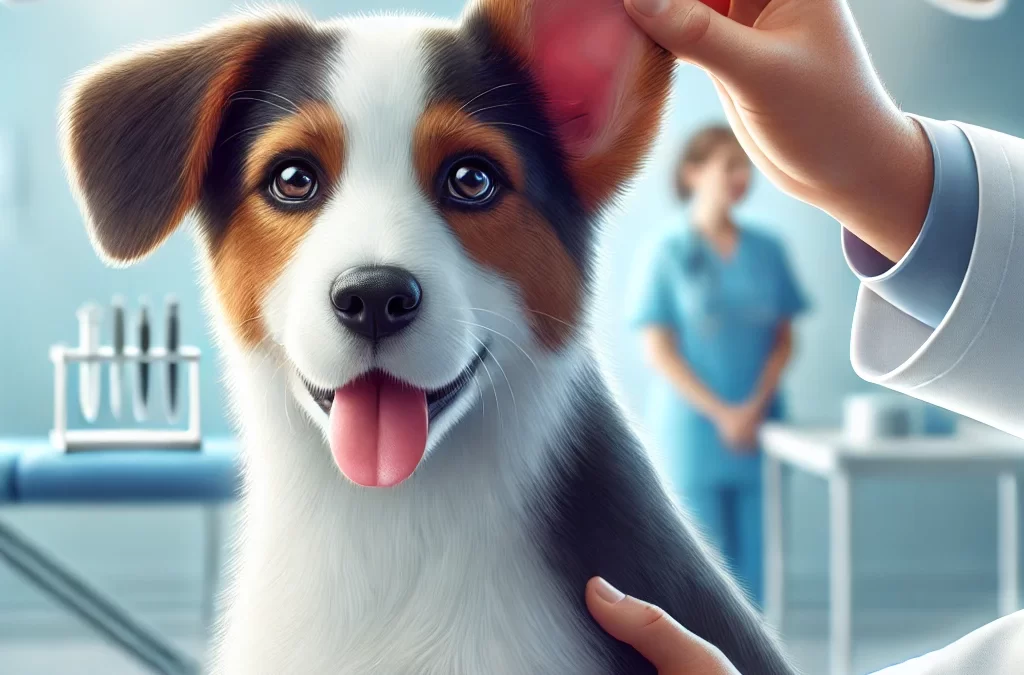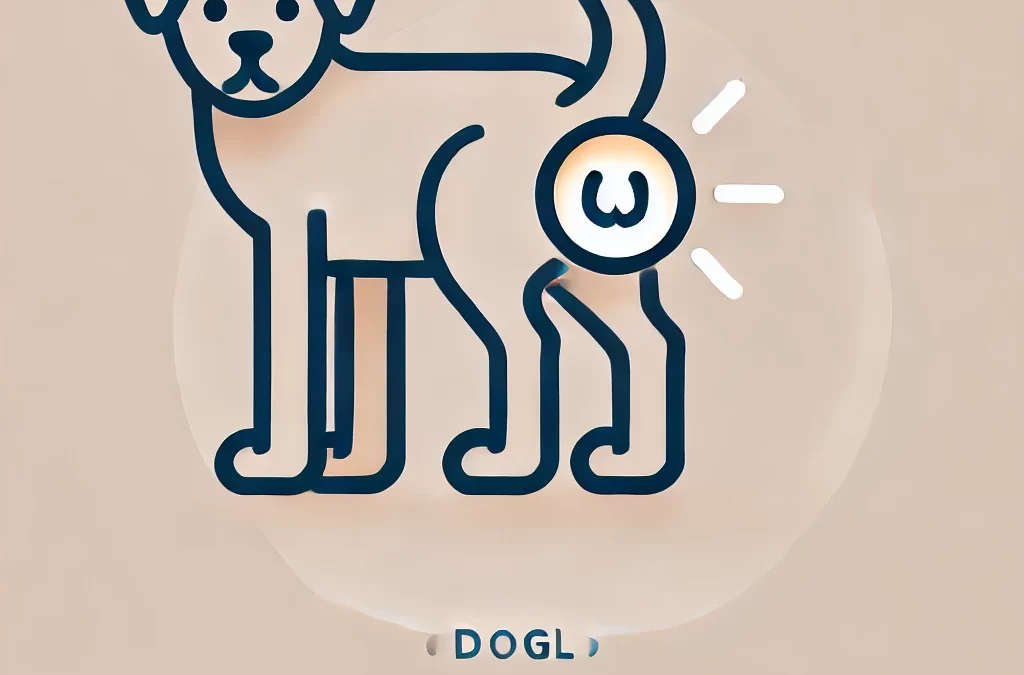
por TCMVET | 14 de dezembro de 2024 | Câncer e tumores caninos
Crescimentos anormais no intestino inferior de cães, embora não tão comuns quanto outros problemas de saúde, são um fenômeno preocupante que muitas vezes passa despercebido. Esses crescimentos, que podem variar de pólipos benignos a tumores malignos, afetam a digestão, o conforto geral e a saúde a longo prazo de um cão. Entender suas causas, sinais e opções de tratamento é crucial para garantir uma melhor qualidade de vida para seu companheiro peludo.
O que são crescimentos anormais no intestino inferior?
O termo “crescimentos anormais” abrange uma variedade de condições que afetam o trato intestinal inferior, que inclui o cólon, reto e ânus. Esses crescimentos podem ser:
- Pólipos: Tumores benignos e não cancerígenos que podem causar desconforto, mas raramente se espalham.
- Adenocarcinomas: Tumores malignos originários de células glandulares, geralmente agressivos e invasivos.
- Leiomiossarcomas: Tumores malignos raros que afetam a camada muscular lisa do intestino.
- Linfomas: Câncer que afeta os tecidos linfáticos dos intestinos, comum em cães com predisposição a doenças gastrointestinais.
Causas de crescimentos intestinais inferiores em cães
As causas exatas variam, mas vários fatores contribuem para o desenvolvimento de crescimentos anormais:
- Age: Cães mais velhos são mais propensos a tumores intestinais devido ao envelhecimento celular e mutações.
- Predisposição da raça: Raças como pastores alemães e collies têm maiores riscos de câncer gastrointestinal.
- Dieta e ambiente: Dietas de baixa qualidade, exposição a toxinas ou irritação intestinal crônica podem levar ao crescimento anormal de células.
- Inflamação crônica: Condições como a doença inflamatória intestinal (DII) criam um ambiente propício para crescimentos anormais.
Sinais e sintomas a serem observados
Crescimentos anormais no intestino inferior frequentemente apresentam sintomas sutis ou ambíguos, tornando a detecção precoce um desafio. Os principais sinais incluem:
- Diarreia crônica: Fezes moles persistentes, geralmente com muco ou sangue.
- Constipação ou esforço: Dificuldade para evacuar devido à obstrução causada por tumores.
- Sangue nas fezes (hematoquezia): Sangue vermelho vivo ou escuro como alcatrão é um indicador comum.
- Dor abdominal: Os cães podem apresentar sinais como choramingo, inquietação ou postura curvada.
- Weight Loss: Unexplained weight loss despite a normal appetite.
- Lethargy and Weakness: Uma diminuição nos níveis de energia devido à anemia ou efeitos sistêmicos do crescimento.
Diagnóstico: Desvendando o Problema Oculto
O diagnóstico de tumores intestinais inferiores requer uma combinação de exames clínicos e diagnósticos avançados:
- Exame físico: Um exame retal pode revelar crescimentos palpáveis no trato inferior.
- Imagem: Raios X, ultrassons ou tomografias computadorizadas ajudam a visualizar tumores e sua localização.
- Endoscopia: Uma câmera inserida no cólon pode identificar e, às vezes, fazer biópsia de tecido anormal.
- Biópsia: Amostras de tecido confirmam se o crescimento é benigno ou maligno, orientando o tratamento.
Opções de tratamento: adaptadas para cada caso
O tratamento varia dependendo do tipo, localização e estágio do crescimento:
- Remoção cirúrgica: O tratamento de primeira linha para tumores localizados, particularmente pólipos benignos ou pequenos tumores malignos.
- Quimioterapia: Recomendado para cânceres que metastatizaram ou não podem ser totalmente removidos cirurgicamente.
- Radioterapia: Usado em conjunto com cirurgia para tumores agressivos.
- Cuidado paliativo: Focado no controle da dor e na melhoria do conforto do cão em casos avançados ou intratáveis.
Suporte Holístico para Saúde Digestiva
Embora os tratamentos médicos tratem da condição primária, abordagens holísticas podem fornecer suporte adicional:
- Dietas ricas em fibras: Promove uma digestão mais suave e reduz a irritação no intestino grosso.
- Probióticos: Melhora a flora intestinal e promove a saúde intestinal geral.
- Cúrcuma (Curcumina): Conhecido por suas propriedades anti-inflamatórias e potencialmente anticancerígenas.
- Óleo CBD: Ajuda a reduzir a inflamação e a dor, melhorando a qualidade de vida do cão.
Medidas preventivas: reduzindo o risco
Embora nem todos os crescimentos possam ser prevenidos, há medidas que você pode tomar para diminuir o risco do seu cão:
- Check-ups regulares: Exames veterinários anuais ajudam a detectar anormalidades precocemente.
- Dietas de alta qualidade: Forneça alimentos equilibrados e nutritivos para minimizar o estresse gastrointestinal.
- Monitore a saúde das fezes: Fique de olho nas mudanças nos hábitos intestinais e de fezes do seu cão.
- Limite a exposição a toxinas: Evite dar comida de baixa qualidade ou expor seu cão a produtos químicos nocivos.
O impacto emocional nos pais de animais de estimação
Cuidar de um cão com crescimentos intestinais pode ser emocionalmente desgastante. É natural sentir-se ansioso ou sobrecarregado, mas lembre-se de que você não está sozinho. Muitos recursos, incluindo grupos de apoio e profissionais veterinários, podem orientá-lo nessa jornada.
Conclusão: Conhecimento é poder
Crescimentos anormais no intestino inferior de cães podem parecer assustadores, mas com detecção precoce e cuidado proativo, muitos cães podem levar vidas gratificantes. Fique vigilante, procure aconselhamento veterinário regular e forneça o melhor cuidado possível ao seu amigo de quatro patas.

por TCMVET | 14 de dezembro de 2024 | Câncer e tumores caninos
Quando se trata de caroços na orelha de um cão, uma possibilidade que muitas vezes surpreende os donos é uma histiocitoma. Esses crescimentos benignos são comuns em cães mais jovens e podem parecer alarmantes devido ao seu rápido desenvolvimento e localização proeminente. No entanto, eles geralmente são inofensivos e muitas vezes se resolvem sozinhos. Vamos mergulhar no que torna os histiocitomas únicos e como você pode fornecer o melhor cuidado para seu amigo peludo.
O que é um histiocitoma?
Um histiocitoma é um tumor não cancerígeno que surge da Células de Langerhans, um tipo de célula imune encontrada na pele. Esses tumores são mais comumente vistos em cães com menos de três anos de idade e geralmente ocorrem na cabeça, orelhas ou membros.
No caso da orelha, os histiocitomas frequentemente se formam na superfície externa ou na borda, criando um caroço visível que pode preocupar os donos de animais de estimação. Apesar de sua aparência dramática, os histiocitomas são considerados uma das formas mais benignas de crescimentos em cães.
Por que os histiocitomas ocorrem em cães?
A causa exata dos histiocitomas é desconhecida, mas acredita-se que eles estejam relacionados a uma resposta imunológica hiperativa em cães mais jovens. Raças como Boxers, Labradores e Bulldogs parecem ter uma predisposição maior, embora qualquer raça possa desenvolver uma.
Como identificar um histiocitoma na orelha
Os histiocitomas são distintos em sua aparência e comportamento, tornando-os relativamente fáceis de detectar:
- Aparência: Um caroço vermelho, redondo e elevado, geralmente sem pelos e liso. Na orelha, pode parecer especialmente pronunciado devido à pele fina e à falta de pelos.
- Tamanho: Geralmente pequeno, com cerca de 0,5 a 2 cm de diâmetro.
- Textura: Firme ao toque, com superfície levemente ulcerada ou brilhante.
- Comportamento: Ao contrário dos tumores malignos, os histiocitomas geralmente não causam desconforto, a menos que sejam arranhados ou infectados.
Você deveria se preocupar?
Um dos aspectos mais tranquilizadores dos histiocitomas é que eles são autolimitante, o que significa que muitas vezes desaparecem sem intervenção dentro de 2 a 3 meses. No entanto, a consulta veterinária é crucial para confirmar o diagnóstico e descartar condições mais sérias, como:
- Tumores de mastócitos
- Carcinoma de células escamosas
- Infecções ou abscessos de ouvido
O que esperar durante o diagnóstico
Os veterinários geralmente usam os seguintes métodos para identificar um histiocitoma:
- Exame físico: Uma inspeção detalhada do caroço e da saúde geral do cão.
- Aspiração por Agulha Fina (PAAF): Uma pequena amostra de células é extraída para análise microscópica.
- Biópsia: Em casos raros, uma biópsia pode ser realizada para confirmação adicional.
Opções de tratamento e cuidados
A maioria dos histiocitomas se resolve por conta própria, mas certos casos podem exigir intervenção:
- Nenhum tratamento necessário: Se o caroço não estiver incomodando o cão, ele pode ser deixado para regredir naturalmente.
- Remoção cirúrgica: Em casos raros em que o crescimento causa irritação ou demora a cicatrizar, o veterinário pode recomendar a remoção.
- Topical Treatments: Se o histiocitoma se tornar ulcerado, cremes ou sprays antibióticos podem prevenir a infecção.
Dicas de cuidados em casa
Enquanto espera a resolução do histiocitoma, há medidas que você pode tomar para garantir que seu cão permaneça confortável:
- Evite arranhões: Use uma coleira elizabetana se seu cão coçar a orelha excessivamente, pois isso pode causar sangramento ou infecção.
- Monitore o crescimento: Fique de olho no tamanho, cor e textura do caroço. Mudanças rápidas podem justificar uma visita de acompanhamento.
- Limpe a área: Limpe suavemente o ouvido com uma solução recomendada pelo veterinário para reduzir o risco de infecções secundárias.
Quais são as diferenças entre um histiocitoma de orelha?
Histiocitomas na orelha podem ser mais perceptíveis devido à localização sensível da orelha. Eles podem fazer com que a orelha pareça assimétrica ou flácida, e os cães podem balançar a cabeça com mais frequência. Esses sinais específicos tornam o monitoramento e o cuidado ainda mais importantes.
Uma abordagem natural para apoiar a cura do seu cão
Alguns donos de animais exploram terapias naturais para complementar os cuidados veterinários tradicionais. Embora esses métodos não sejam uma cura, eles podem ajudar na saúde geral da pele:
- Ácidos gordurosos de omega-3: Promova uma resposta imunológica saudável e reduza a inflamação.
- Creme de Calêndula: Um remédio herbal calmante para aliviar a irritação ao redor do caroço.
- Óleo CBD: Pode ajudar a reduzir arranhões e estresse associados ao desconforto.
Quando procurar aconselhamento veterinário
Embora os histiocitomas sejam benignos, consulte seu veterinário se notar:
- O caroço cresce rapidamente ou muda de textura.
- Coceira, sangramento ou secreção persistentes.
- O histiocitoma não regrediu após 3 meses.
Pensamentos finais
Um histiocitoma na orelha do seu cão pode parecer preocupante à primeira vista, mas é tipicamente uma condição inofensiva que se resolve com pouca ou nenhuma intervenção. Ao entender sua natureza única e fornecer cuidados atenciosos, você pode garantir que seu cão permaneça feliz e saudável durante todo o processo.

por TCMVET | 13 de dezembro de 2024 | Câncer e tumores caninos
O câncer de nariz em cães, também conhecido como câncer nasal, é uma condição relativamente rara, mas agressiva, que afeta a cavidade nasal ou os seios nasais. Embora seja responsável por menos de 1% de todos os cânceres caninos, sua gravidade está em sua natureza invasiva e na dificuldade de detecção precoce. Este artigo se aprofunda nos sintomas, diagnóstico, opções de tratamento e cuidados de suporte para cães que lutam contra o câncer de nariz.
O que é câncer de nariz em cães?
O câncer de nariz canino envolve principalmente tumores que se desenvolvem dentro das passagens nasais ou seios nasais. O tipo mais comum é adenocarcinoma, mas outras formas como carcinoma de células escamosas, fibrossarcoma ou osteossarcoma também podem ocorrer. Essa condição geralmente afeta cães mais velhos, com raças maiores parecendo ter um risco ligeiramente maior.
Sinais e sintomas
Os primeiros sinais de câncer nasal podem ser sutis e muitas vezes são confundidos com infecções respiratórias ou alergias. Conforme a doença progride, os sintomas se tornam mais pronunciados. Fique atento ao seguinte:
- Secreção nasal persistente
Secreção unilateral (afetando uma narina) com sangue ou muco é um sintoma característico.
- Espirros frequentes
Espirros crônicos que não melhoram com tratamento podem indicar irritação nasal causada por um tumor.
- Inchaço facial
Pode ocorrer inchaço ao redor do nariz, olhos ou testa à medida que o tumor invade as estruturas circundantes.
- Dificuldade respiratória
Ronco ou respiração ruidosa podem indicar um bloqueio nas passagens nasais.
- Sangramento nasal (epistaxe)
Sangramento nasal intermitente ou contínuo é frequentemente relatado.
- Sintomas neurológicos
Se o tumor se estender para o cérebro, sintomas como convulsões, desorientação ou alterações comportamentais podem aparecer.
- Perda de apetite e perda de peso
Como acontece com muitos tipos de câncer, os efeitos sistêmicos podem levar à redução da ingestão de alimentos e à perda de peso.
Diagnóstico
O diagnóstico do câncer de nariz envolve uma avaliação completa, incluindo:
- Exame físico:Um veterinário pode verificar se há assimetria no rosto ou sons anormais durante a respiração.
- Rinoscopia:Uma pequena câmera inserida nas passagens nasais ajuda a visualizar o tumor.
- Imagem: Raios X, tomografias computadorizadas ou ressonâncias magnéticas fornecem imagens detalhadas do tumor e sua disseminação.
- Biópsia: Amostras de tecido confirmam o tipo e a gravidade do câncer.
Opções de tratamento
O tratamento depende do tamanho, tipo e estágio do tumor, bem como da saúde geral do seu cão. As opções incluem:
- Radioterapia
A radiação é o tratamento mais eficaz para o câncer nasal, visando diminuir o tumor e aliviar os sintomas. Embora possa não curar o câncer, pode melhorar significativamente a qualidade de vida.
- Cirurgia
A remoção cirúrgica do tumor é desafiadora devido à anatomia complexa da área nasal, mas pode ser tentada em casos específicos.
- Quimioterapia
A quimioterapia é menos comumente usada, mas pode ser recomendada para certos tipos de tumores ou como um complemento a outros tratamentos.
- Cuidado paliativo
Quando o tratamento curativo não é uma opção, os cuidados paliativos se concentram no alívio da dor e do desconforto por meio de medicamentos, incluindo anti-inflamatórios, analgésicos e descongestionantes nasais.
Terapias naturais para cuidados de suporte
Incorporar abordagens holísticas junto com tratamentos convencionais pode aumentar o conforto do seu cão:
- Suplementos de ervas
Ervas como cúrcuma (curcumina) e astrágalo Acredita-se que tenham propriedades anti-inflamatórias e de reforço imunológico.
- Ajustes dietéticos
Uma dieta de alta qualidade e com baixo teor de carboidratos promove a saúde geral e reduz a inflamação.
- Óleo CBD
O canabidiol pode ajudar a controlar a dor e reduzir a ansiedade em cães com câncer avançado.
Prognóstico e Qualidade de Vida
O prognóstico para câncer de nariz canino depende de fatores como tipo de tumor e estágio no diagnóstico. Com a radioterapia, muitos cães apresentam alívio dos sintomas e tempos de sobrevivência estendidos, geralmente variando de 8 a 18 meses. Sem tratamento, a doença progride rapidamente, geralmente dentro de semanas a alguns meses.
Como apoiar seu cão
- Monitorar sintomas: Monitore as mudanças na respiração, na alimentação ou nos níveis de energia.
- Visitas frequentes ao veterinário: Exames regulares garantem que a condição do seu cão seja monitorada de perto.
- Proporcionar conforto: Cama macia, ambiente tranquilo e fácil acesso a comida e água fazem uma grande diferença.
Pensamentos finais
O câncer de nariz canino é um diagnóstico assustador, mas com intervenção oportuna e um plano de cuidados abrangente, você pode dar ao seu cão a melhor qualidade de vida possível. Sempre consulte seu veterinário para explorar opções de tratamento adaptadas às necessidades específicas do seu cão.

por TCMVET | 13 de dezembro de 2024 | Câncer e tumores caninos
O câncer renal em cães, embora raro, é uma condição séria que pode impactar significativamente a qualidade de vida do seu amigo peludo. Reconhecer os sinais precocemente pode fazer uma grande diferença nos resultados do tratamento. Neste artigo, exploraremos os sinais reveladores do câncer renal, discutiremos por que ele geralmente passa despercebido e forneceremos insights sobre opções de cuidados de suporte.
O que é câncer renal em cães?
Câncer renal refere-se ao crescimento anormal de células em um ou ambos os rins. Em cães, o carcinoma de células renais é o tipo mais comum de câncer renal, afetando principalmente cães mais velhos. Embora sua causa exata permaneça obscura, a predisposição genética e a exposição a toxinas podem desempenhar um papel.
Os sinais sutis: por que o câncer renal geralmente se esconde à vista de todos
Os sintomas do câncer renal podem ser facilmente confundidos com problemas menos graves, como infecções do trato urinário ou envelhecimento geral. Essa sobreposição de sinais geralmente atrasa o diagnóstico. Aqui está o que procurar:
- Micção frequente ou dificuldade para urinar
Um aumento na frequência de micção ou desconforto visível ao urinar pode indicar estresse renal ou obstrução causada por um tumor.
- Sangue na urina (hematúria)
Urina vermelha brilhante ou marrom escura é um sinal de alerta importante de que algo pode estar errado com os rins do seu cão.
- Perda de apetite
Uma repentina falta de interesse por comida, combinada com perda de peso, pode indicar problemas sistêmicos relacionados à função renal.
- Letargia
Se o seu cão parece anormalmente cansado ou pouco disposto a realizar atividades diárias, isso pode indicar fadiga subjacente causada por disfunção renal.
- Abdominal Swelling
Inchaço no abdômen pode ser resultado de um grande tumor renal pressionando outros órgãos.
- Vômitos e náuseas
À medida que o câncer renal progride, toxinas se acumulam no sangue, causando problemas gastrointestinais.
Como o câncer renal difere de outras condições
Muitos dos sintomas acima imitam aqueles de doença renal, infecções da bexiga ou até mesmo diabetes. No entanto, no câncer renal, esses sinais são mais persistentes e pioram com o tempo sem tratamento.
O papel do diagnóstico
A detecção do câncer renal requer uma combinação de testes:
- Ultrassons e raios X fornecem imagens de possíveis tumores.
- Exames de sangue revelam função renal anormal ou anemia.
- A análise de urina pode identificar células sanguíneas ou cancerígenas microscópicas.
Os veterinários também podem recomendar uma biópsia para confirmar o tipo e a gravidade do câncer.
Terapias naturais para cuidados de suporte
Embora a remoção cirúrgica do rim afetado seja frequentemente o tratamento primário, abordagens holísticas podem complementar métodos tradicionais para melhorar a qualidade de vida do seu cão.
- Remédios herbais
Ervas como Chuanxiong (Livo-de-Szechuan) podem ajudar a melhorar a circulação e reduzir a inflamação ao redor dos rins.
- Ajustes dietéticos
Uma dieta com baixo teor de fósforo e proteína de alta qualidade auxilia na função renal e reduz a carga de trabalho do rim remanescente.
- Óleo CBD
O canabidiol pode ajudar a controlar a dor e reduzir o estresse em cães em tratamento.
Dicas de prevenção: você pode reduzir o risco?
Embora seja impossível prevenir completamente o câncer renal, há medidas que você pode tomar para promover a saúde geral dos rins:
- Forneça água fresca e filtrada.
- Evite a exposição a agentes cancerígenos conhecidos, como pesticidas.
- Agende exames veterinários regulares, especialmente para cães idosos.
Quando consultar um veterinário
Se você notar qualquer um dos sintomas acima, consulte seu veterinário imediatamente. A intervenção precoce pode levar a melhores resultados, seja por meio de cirurgia, quimioterapia ou cuidados paliativos.
Pensamentos finais
Câncer renal em cães é um diagnóstico desafiador, mas ser proativo sobre a saúde do seu cão pode fazer uma grande diferença. Ao reconhecer mudanças sutis e buscar aconselhamento médico oportuno, você pode garantir que seu amado animal de estimação receba o cuidado e o conforto que merece.

por TCMVET | 12 de dezembro de 2024 | Câncer e tumores caninos
O câncer anal em cães, embora relativamente incomum, é uma condição séria que requer atenção imediata. O tipo mais frequentemente diagnosticado é adenocarcinoma do saco anal, um tumor maligno que surge das glândulas anais. Este tipo de câncer é conhecido por sua natureza agressiva e potencial para se espalhar para outras partes do corpo. Neste artigo, exploramos os sintomas, diagnóstico, opções de tratamento e perspectivas para cães afetados pelo câncer anal.
O que é câncer anal em cães?
Câncer anal refere-se ao desenvolvimento de tumores malignos nas glândulas anais ou próximo a elas. Essas glândulas, localizadas em ambos os lados do ânus, desempenham um papel na secreção de fluidos usados para marcar território. Quando o câncer se desenvolve nessas glândulas, ele geralmente cresce rapidamente e pode metastatizar para os linfonodos próximos, pulmões ou outros órgãos.
Sintomas de câncer anal em cães
Os sintomas do câncer anal em cães podem variar dependendo do tamanho e da localização do tumor e se ele se espalhou. Sinais comuns incluem:
- Caroços ou inchaço: Uma massa ou inchaço perceptível perto do ânus.
- Dificuldade para defecar: Esforço, dor ou alterações no formato das fezes devido ao tumor obstruindo o reto.
- Sangramento: Sangue ao redor do ânus ou nas fezes.
- Rastejar ou lamber: Os cães podem correr no chão ou lamber excessivamente a área devido ao desconforto.
- Sintomas de hipercalcemia: Aumento da sede, micção frequente, letargia ou fraqueza causados por níveis elevados de cálcio no sangue.
- Perda de peso e perda de apetite: Casos avançados podem levar a sintomas sistêmicos como perda de peso e redução do apetite.
Como o câncer anal é diagnosticado?
Para diagnosticar o câncer anal, os veterinários usam uma combinação de:
- Exame físico: Verificar se há caroços, inchaço ou desconforto na área anal.
- Aspiração por agulha fina ou biópsia: Amostragem do tecido tumoral para confirmar malignidade.
- Exames de sangue: Identificação de hipercalcemia ou outras anormalidades.
- Imagem: Raios X, ultrassom ou tomografias computadorizadas para determinar a extensão do câncer e verificar se há metástase.
Opções de tratamento para câncer anal em cães
A abordagem do tratamento depende do estágio e da disseminação do câncer. As opções comuns incluem:
- Cirurgia: O tratamento primário para câncer anal localizado é a remoção cirúrgica do tumor e dos gânglios linfáticos potencialmente afetados.
- Radioterapia: Frequentemente usado em combinação com cirurgia para atingir células cancerígenas residuais.
- Quimioterapia: Recomendado para casos em que o câncer sofreu metástase ou como complemento a outros tratamentos.
- Cuidado paliativo: Em casos avançados, o controle da dor, ajustes na dieta e cuidados de suporte podem melhorar a qualidade de vida.
Prognóstico para cães com câncer anal
A perspectiva para cães com câncer anal depende de vários fatores, incluindo o tamanho do tumor, se ele se espalhou e o tratamento fornecido. A detecção precoce e o tratamento agressivo melhoram as taxas de sobrevivência, com muitos cães experimentando longos períodos de boa qualidade de vida após o tratamento. No entanto, casos avançados com metástase têm um prognóstico menos favorável.
Cuidando de um cão com câncer anal
Como dono de um animal de estimação, fornecer um ambiente de apoio e confortável para seu cão é essencial. Siga estas dicas:
- Visitas regulares ao veterinário: Agende exames frequentes para monitorar a condição do seu cão.
- Nutrition: Ofereça uma dieta balanceada e adaptada às necessidades do seu cão durante o tratamento.
- Gerenciamento da dor: Trabalhe com seu veterinário para garantir que seu cão esteja confortável.
- Suporte emocional: Ofereça amor e segurança para ajudar seu cão a lidar com o estresse do tratamento.
Conclusão
Embora o câncer anal em cães seja agressivo, a detecção precoce e um plano de tratamento abrangente podem fazer uma diferença significativa nos resultados. Fique atento aos sintomas e procure atendimento veterinário imediatamente se notar quaisquer sinais incomuns. Com o suporte e o cuidado certos, seu cão pode manter uma boa qualidade de vida, mesmo em tempos desafiadores.





